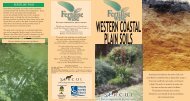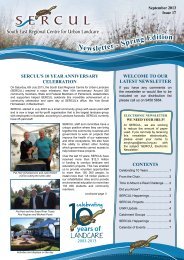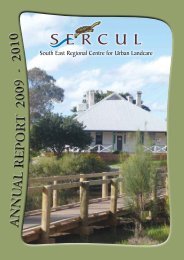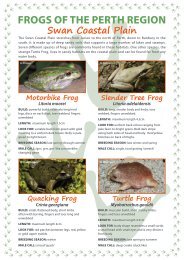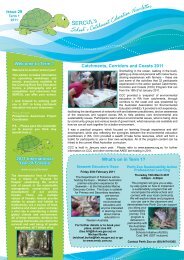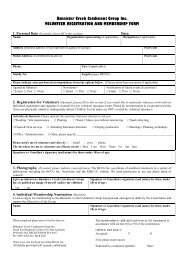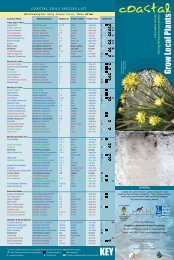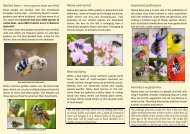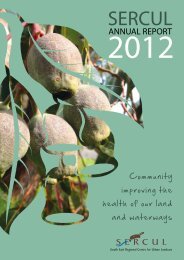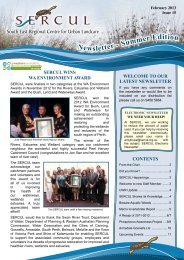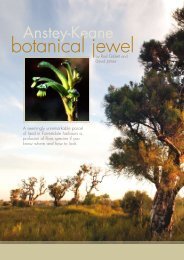Phosphorus Awareness Project brochure - SERCUL
Phosphorus Awareness Project brochure - SERCUL
Phosphorus Awareness Project brochure - SERCUL
Create successful ePaper yourself
Turn your PDF publications into a flip-book with our unique Google optimized e-Paper software.
ABOUT THE PHOSPHORUS<br />
AWARENESS PROJECT<br />
The <strong>Phosphorus</strong> <strong>Awareness</strong> <strong>Project</strong> is a community<br />
education campaign aiming to reduce nutrient loads in<br />
the Swan-Canning catchment.<br />
The campaign educates the<br />
community, schools, Local<br />
Government and high nutrient<br />
use industries about the impact<br />
of too many nutrients in the<br />
rivers and wetlands and how to<br />
reduce the levels.<br />
The project is managed by the<br />
South East Regional Centre<br />
for Urban Landcare and is<br />
supported by the Swan River<br />
Trust.<br />
The project seeks to promote:<br />
• appropriate fertiliser practices for the soils of the region<br />
- Fertilise Wise;<br />
• the growing of local native plants<br />
• the use of phosphorus-free detergents, especially in<br />
unsewered areas;<br />
• awareness of the high level of nutrients contained in dog<br />
poo, grass clippings, deciduous leaves and in bread fed<br />
to water birds.<br />
It also seeks to make people aware of the connection<br />
between their backyards, the stormwater drainage system<br />
and the rivers and wetlands.<br />
ALGAE BUSTER<br />
PHOSPHORUS<br />
AWARENESS<br />
PROJECT<br />
CONTACT DETAILS<br />
Amy Krupa<br />
<strong>Phosphorus</strong> <strong>Awareness</strong> <strong>Project</strong> Coordinator<br />
South East Regional Centre for Urban Landcare<br />
69 Horley Road, Beckenham, WA, 6107<br />
Phone: 9458 5664<br />
Email: amykrupa@sercul.org.au<br />
www.sercul.org.au/pap.html<br />
<strong>Phosphorus</strong><br />
<strong>Awareness</strong><br />
<strong>Project</strong><br />
Improving the health<br />
of wetlands and the<br />
Swan and Canning<br />
Rivers<br />
ALGAE BUSTER<br />
SUPPORTED BY<br />
Caring for the Swan Canning Riverpark<br />
PHOSPHORUS<br />
AWARENESS<br />
PROJECT
OUR RIVERS AND WETLANDS<br />
ARE GOING DOWN THE DRAIN<br />
The Swan and Canning Rivers and many wetlands are<br />
suffering from the effects of high nutrient levels, particularly<br />
phosphorus and nitrogen, which leads to regular, sometimes<br />
toxic, algal blooms in the warmer months. High nutrient<br />
levels in the rivers are a result of overuse of nutrients in the<br />
catchment.<br />
Nutrients, phosphorus and nitrogen, are plant nutrients that<br />
are naturally present in our waterways and soils in very low<br />
concentrations. The problem is that nutrients accumulate as<br />
a result of human activity. We are using too many nutrients<br />
in our daily lives.<br />
Only low levels of nutrients can be retained on Perth’s<br />
porous, sandy soils as they contain few metals, clay, silt or<br />
organic matter to bind the nutrients, particularly phosphorus.<br />
Nutrients just wash out with water (rain or over-watering)<br />
and may be leached into ground and surface waters.<br />
Even in those areas of the catchment where the soil is<br />
heavy clay and phosphorus retention is greater, there are<br />
still problems. Surface run-off and soil erosion causes the<br />
release of phosphorus into the rivers and wetlands.<br />
Nutrients also get washed down stormwater drains which<br />
end up, untreated, in our rivers and wetlands.<br />
SOURCES OF NUTRIENTS<br />
The nutrients that enter the Swan and Canning Rivers come<br />
from:<br />
• fertilisers;<br />
• grass clippings;<br />
• deciduous leaves;<br />
• detergents;<br />
• sewage;<br />
• intensive agriculture;<br />
• dog poo; and<br />
• bread fed to water birds.<br />
ALGAL BLOOMS<br />
Algae are plants that grow naturally in our rivers and<br />
wetlands and are an important part of the river ecosystem.<br />
However, algae use excess nutrients to grow and multiply<br />
rapidly to large numbers, thriving when the weather is warm<br />
and sunny and the water flow is slow. This is known as an<br />
algal bloom and they are undesirable because:<br />
• they can be toxic to humans and animals and can cause<br />
skin irritations<br />
• they kill fish by starving them of oxygen (when algae<br />
decomposes)<br />
• are unsightly and foul smelling<br />
• prevent recreational use of the river.<br />
HOW TO HELP OUR RIVERS AND<br />
WETLANDS<br />
Cleaning up the rivers and wetlands is simply a matter of<br />
reducing nutrient loads in the Swan-Canning catchment.<br />
There are many things you can do to reduce the input of<br />
nutrients most of which will take little effort and even less<br />
time including:<br />
• Fertilise Wise - use Fertilise Wise endorsed efffective and<br />
responsible all purpose fertilisers.<br />
• If you must use a chemical fertiliser, use a complete fertiliser<br />
with a Nitrogen to <strong>Phosphorus</strong> to Potassium (N:P:K) ratio of<br />
10:1:6. Apply sparingly in spring or autumn only.<br />
• Don’t fertilise near waterways or road verges<br />
• Improve your soil by adding organic matter or clay<br />
• Grow local native plants<br />
• Compost your garden waste<br />
• Don’t let grass clippings, leaves or soil go down the drain<br />
• Take the catcher off the mower - recycle the nutrients<br />
• Don’t over-water<br />
• Use P free detergents (Read the labels)<br />
• Wash your car on the grass, not the driveway<br />
• Pick up after your dog on walks<br />
• Do not feed bread to water birds<br />
• Join the <strong>Phosphorus</strong> <strong>Awareness</strong> <strong>Project</strong> and spread the<br />
message about saving our rivers and wetlands.<br />
PAP<br />
We all have a responsibility to reduce nutrient loads to the rivers and wetlands<br />
to protect their future health and our recreational use.




